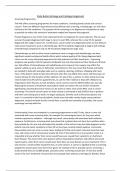Essay
Unit 20 Aim B: Histology and Cytology Assignment (DISTINCTION)
- Module
- Unit 20 - Biomedical Science
- Institution
- PEARSON (PEARSON)
This is my distinction grade assignment for unit 20 aim B on histology and cytology, normal vs abnormal cell morphology, cancer and screenings, biopsies and more. All criteria were met and I was awarded distinction. If you have any questions or concerns, please do not hesitate to get in touch. ...
[Show more]












